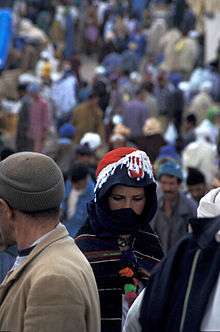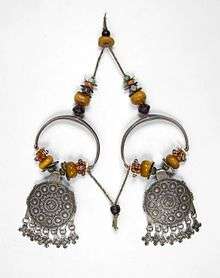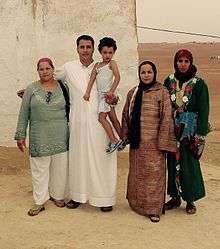Shilha people
| Total population | |
|---|---|
| ~4.77 million[1] | |
| Regions with significant populations | |
| Morocco-Atlas Mountains, Sous Valley | |
| Languages | |
| Shilha | |
| Religion | |
| Predominantly Muslim | |
| Related ethnic groups | |
| Berbers |
The Shilha people, also called Shluh or Chleuh, are a major Berber subgroup primarily inhabiting the southwestern mountains, Sous River, and southern coastal regions of Morocco.[2][3] They also live in Mauritania.[4][5]
Overview

The Shilha traditionally call themselves Shlḥi. This endonym is rendered as Chleuhs in French.[6] The Shilha are also known as Shluh and Shlöh.[2] Among Arabic speakers, Shluh serves as an appellation for Berbers generally, although Amazigh/Imazighin is the proper Berber self-name for Berbers as a whole.[7]
The Shilha people live mainly in Morocco's southern Atlantic coast, the High Atlas Mountains, the Anti Atlas mountains, and the Sous Valley.[2] They are of Berber origin, which along with the Shluh people, includes other ethnic subgroups such as the Tuareg, Rif, Kabyle, Shawia and Beraber.[8] The Shilha people are a part of Morocco's Berber-speaking minority, and the southernmost residing Berber population.[9][10]
History

In antiquity, Berbers traded with the Phoenicians and Carthaginians in commercial entrepots and colonies along the northwestern littoral. They established the ancient kingdom of Mauretania, which fell under Roman rule in 33 CE, before eventually being reunited under Berber sovereignty.[11] During the 7th century, the Islamic Umayyad Caliphate invaded the Berber and Byzantine strongholds in the Maghreb, seizing Carthage in 698 AD. Although the Umayyads nominally controlled Morocco over the following years, their rule was tenuous due to Berber resistance. The polity eventually collapsed and was taken over by the Abbasid dynasty. In 789 AD, with the approval of the locals, a former Umayyad courtier established the Idrisid dynasty. It lasted until 970 AD, as various petty states vied for control over the ensuing centuries. After 1053, Morocco was ruled by a succession of Muslim dynasties founded by Berber tribes. Among these were the Almoravid dynasty (1053-1147), the Almohad dynasty (1147-1275), and the Marinid dynasty (1213-1524). In 1668, a sharifan family from the east assumed control and established the incumbent Alawite dynasty.[12]
Over this period, many Shilha moved to the Atlas Mountains to avoid Arab hegemony. The Berber groups that had not retreated to the highlands intermarried with the colonists. However, although the Shilha gradually adopted Islam, they and other Berbers in the mountains have held on to their traditional language, culture and religious customs to varying degrees.[13][14] A small minority of the Shilha people are Christians and Jewish.[11]
The French and Spanish colonial empires partitioned Morocco in 1904, and the southern part of the territory was declared a French protectorate in 1912. Arabization remained an official state policy under both the colonial and succeeding post-independence governments. With the spread of the Berber Spring to Shilha territory during the 1980s, the Shilha sought to reaffirm their Berber roots. This culminated with a proposal by Shilha nationalists in 2013 to establish an independent Sousse state within a greater Morocco federation.[11]
Society

The Shilha mainly live in Morocco's Atlas Mountains and Sous Valley. Traditionally, they are farmers who also keep herds.[15] Some are semi-nomadic, growing crops during the season when water is available, and moving with their herds during the dry season.[2]
The Shluh communities in the southwestern mountains of Morocco cooperated with each other in terms of providing reciprocal grazing rights as seasons changed, as well as during periods of war. These alliances were re-affirmed by annual festive gatherings, where one Shilha community would invite nearby and distant Shilha communities.[16]
Language
The Shilha speak the Shilha language, a Tashelhiyt dialect. It belongs to the Berber branch of the Afro-Asiatic family.[7][17] Their language is sometimes referred to as Sous-Berber.[18][19]
As of 2014, there were around 4.77 million Shilha speakers, constituting 14.1% of the Moroccan population.[1]
The Shilha language differs considerably from certain Berber varieties, such as those spoken by the Tuareg.[20]
See also
Further reading
- "Shluh", Encyclopædia Britannica online, 2008, webpage: EB-Shluh.
References
- 1 2 Haut commissariat au Plan, Moroccan Kingdom, Haut commissariat au Plan. "Recensement général de la Maroc". HCP (in Franch). Haut commissariat du Plan. Retrieved 16 August 2016.
- 1 2 3 4 Wolfgang Weissleder (1978). The Nomadic Alternative: Modes and Models of Interaction in the African-Asian Deserts and Steppes. Walter de Gruyter. pp. 11–12. ISBN 978-3-11-081023-3.
- ↑ Encyclopædia Britannica 2008, Shluh.
- ↑ Paulin G. Djité (2008). The Sociolinguistics of Development in Africa. Multilingual Matters. p. 38. ISBN 978-1-84769-045-6.
- ↑ Ian Ousby (2000). Occupation: The Ordeal of France 1940-1944. Cooper. p. 167. ISBN 978-1-4617-4167-1.
- ↑ Dalby, Andrew (2015). Dictionary of Languages: The definitive reference to more than 400 languages. Bloomsbury Publishing. p. 614. ISBN 1408102145. Retrieved 2 November 2016.
- 1 2 John A. Shoup (2011). Ethnic Groups of Africa and the Middle East: An Encyclopedia. ABC-CLIO. pp. 53–54. ISBN 978-1-59884-362-0.
- ↑ Marian Aguiar (2010). Anthony Appiah and Henry Louis Gates, ed. Encyclopedia of Africa. Oxford University Press. p. 175. ISBN 978-0-19-533770-9.
- ↑ James Stuart Olson (1996). The Peoples of Africa: An Ethnohistorical Dictionary. Greenwood. p. 91. ISBN 978-0-313-27918-8.
- ↑ Marian Aguiar (2010). Anthony Appiah and Henry Louis Gates, ed. Encyclopedia of Africa. Oxford University Press. pp. 106–107. ISBN 978-0-19-533770-9.
- 1 2 3 James B. Minahan (2016). Encyclopedia of Stateless Nations: Ethnic and National Groups around the World, 2nd Edition. ABC-CLIO. pp. 378–379. ISBN 978-1-61069-954-9.
- ↑ Syed Farid Alatas (2005). Applying Ibn Khaldūn: The Recovery of a Lost Tradition in Sociology. Routledge. p. 82. ISBN 1317594002.
- ↑ Douglas Porch (2005). The Conquest of Morocco. Macmillan. p. 7. ISBN 978-1-4299-9885-7.
- ↑ Robert Montagne (1963). Les Berbères et le makhzen dans le sud du Maroc; essai sur la transformation politique des Berbères sédentaires (groupe chleuh) (in French). Paris: F. Alcan. OCLC 1949564.
- ↑ James Stuart Olson (1996). The Peoples of Africa: An Ethnohistorical Dictionary. Greenwood. p. 523. ISBN 978-0-313-27918-8.
- ↑ George Peter Murdock (15 October 1965). Culture and Society: Twenty-Four Essays. University of Pittsburgh Press. pp. 343–344. ISBN 978-0-8229-7406-2.
- ↑ Tachelhit, Ethnologue (2007)
- ↑ Maarten Kossmann (2013). The Arabic Influence on Northern Berber. BRILL Academic. pp. 19–20. ISBN 978-90-04-25309-4.
- ↑ MG Kossmann; HJ Stroomer (1997). Alan S. Kaye, ed. Phonologies of Asia and Africa: Including the Caucasus. Eisenbrauns. pp. 461–462. ISBN 978-1-57506-019-4.
- ↑ Joseph R. Applegate (1957), Berber Studies I: Shilha, Middle East Journal, Vol. 11, No. 3 (Summer, 1957), pages 324-327